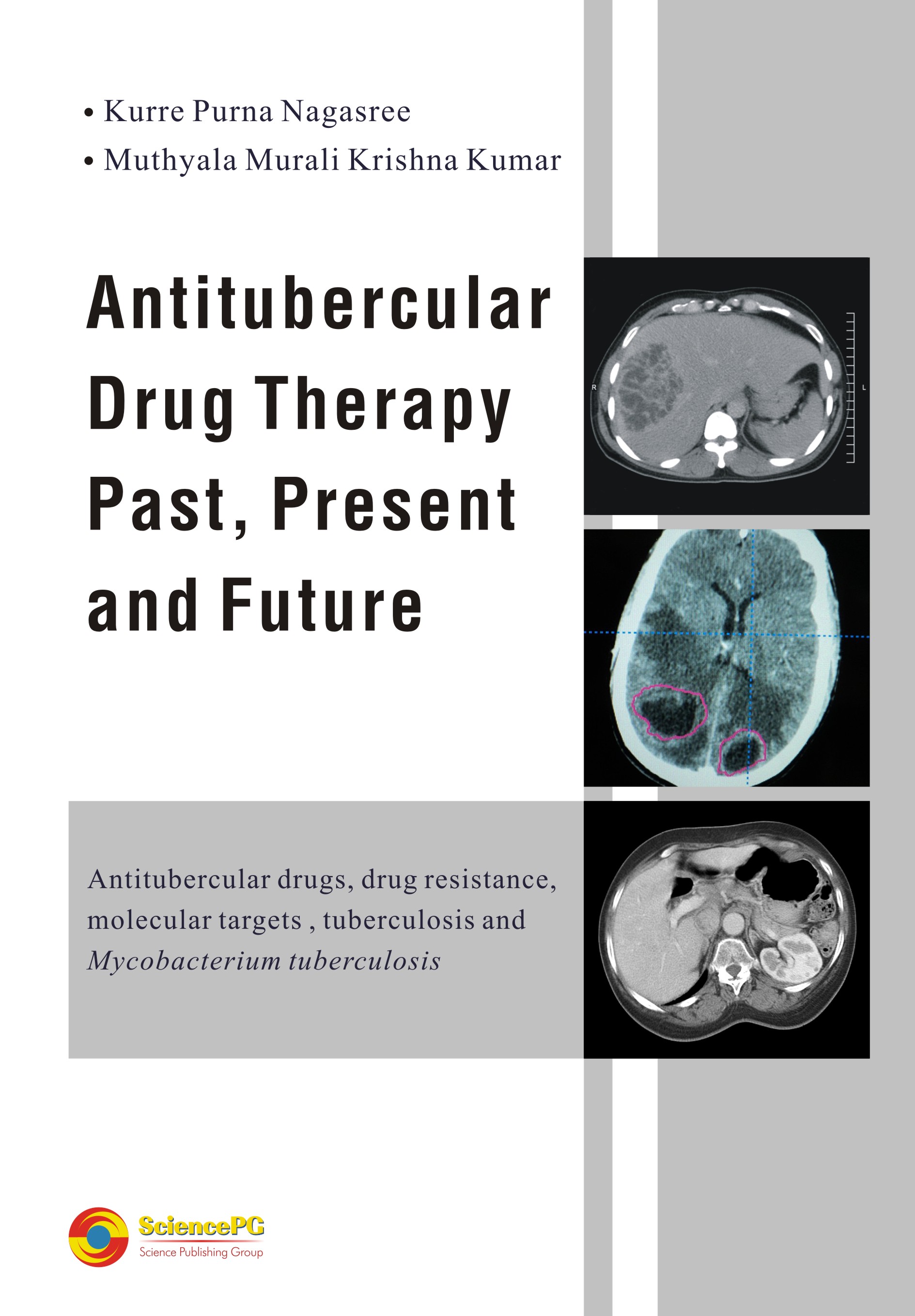
Antitubercular Drug Therapy – Past, Present and Future
K. Purna Nagasree, M. Murali Krishna Kumar © by the authors
ISBN: 978-1-940366-14-2
Published Date: July, 2016
Pages: 138
Publisher: Science Publishing Group
Publication Status: Published
Book Description
This book deals with the introduction of tuberculosis, its worldwide problems, resistance and its posing threat, the available drugs and drug targets. Special emphasis on the threats of multidrug resistance and some methods to overcome it.
Author Introduction
Dr. K. Purna Nagasree DST, Women Scientist -A, Principal Investigator, College of Pharmaceutical Sciences, Andhra University, Visakhapatnam - 530 003, Andhra Pradesh, India.
Dr. M. Murali Krishna Kumar Assistant Professor, College of Pharmaceutical Sciences, Andhra University, Visakhapatnam - 530 003, Andhra Pradesh, India.
Table of Contents
-
-
-
- 1.1 History of Tuberculosis
- 1.1.1 Discovery of the Pathogen
- 1.1.2 Tuberculosis: Global Scenario
- 1.2 Etiology and Pathophysiology
- 1.2.1 M. Tuberculosis (MTB) Complex
- 1.2.2 Structural Complexity of M. Tuberculosis Cell Wall
-
Chapter 2 Chemotherapeutic Agents Used for Tuberculosis
Download
- 2.1 History
- 2.2 Post Antibiotic ERA
- 2.2.1 Streptomycin (SM) and Other Aminoglycoside Antibiotics
- 2.2.2 Isoxyl (Thiocarlide) & Thiacetazone
- 2.2.3 Isoniazid (INH)
- 2.2.4 Pyrazinamide (PZA)
- 2.2.5 P-Aminosalicylic Acid (PAS)
- 2.2.6 Ethambutol (EMB)
- 2.2.7 Cycloserine
- 2.2.8 Rifampicin (RMP)
- 2.2.9 Fluoroquinolones
- 2.3 Conclusions
-
Chapter 3 New Drugs for Treating Tuberculosis in the Clinics and Clinical Trials - An Update
Download
- 3.1 Drugs in Discovery and Development Stages
- 3.1.1 Diamines (SQ109)
- 3.1.2 Nitroimidazofurans and Nitroimidazopyrans
- 3.1.3 Oxazolidinones
- 3.1.4 Diarylquinolines (TMC207, SIRTUROTM)
- 3.2 Preclinical Agents
- 3.2.1 Clofazimine and its Analogues
- 3.2.2 Diarylpyrrole Derivatives
- 3.2.3 BTZ043 and Its Analogues
- 3.2.4 Imidazopyridine Amides
- 3.2.5 Sudoterb (Pyrrole, LL-4858)
- 3.2.6 Peptideformylase Inhibitor BB-3497
- 3.2.7 Phenothiazines
- 3.3 Conclusions
-
Chapter 4 Drug Resistance in Mycobacterium Tuberculosis
Download
- 4.1 Major Mechanisms Involved in Thedevelopment of Drug Resistance in Microorganisms
- 4.1.1 Drug - Resistant Tuberculosis
- 4.1.2 Multi-Drug Resistant Tuberculosis (MDR-TB)
- 4.1.3 Extensive-Drug Resistant Tuberculosis (XDR-TB)
- 4.1.4 Basic Concepts in the Development of Drug-Resistant TB
- 4.2 Molecular Basis of Drug Action and Resistance
- 4.2.1 Isoniazid (INH)
- 4.2.2 Rifampicin (RMP)
- 4.2.3 Pyrazinamide (PZA)
- 4.2.4 Ethambutol (EMB)
- 4.2.5 Aminoglycosides (Streptomycin (SM)/Kanamycin (KM)/Amikacin (AMK)/Capreomycin CPM)
- 4.2.6 Fluoroquinolones (FQ)
- 4.2.7 Ethionamide (ETH)/Prothionamide (PTH) and Thioamides
- 4.2.8 Oxazolidinones
- 4.2.9 Cycloserine
- 4.3 New Drugs, New Targets and New Resistance Mechanisms
- 4.3.1 Nitroimidazoles
- 4.3.2 SQ109
- 4.3.3 Bedaquiline (TMC207, R207910, Sirturo®)
- 4.3.4 Benzothiazinones
- 4.4 Conclusions
-
Chapter 5 Strategies for Anti-Tubercular Drug Development
Download
- 5.1 Cell Wall Components Synthesis and Assemblage
- 5.1.1 Biosynthesis of Mycolic Acids and Other Lipids
- 5.1.2 Mycobacteria Possessing FAS-I and FAS-II Enzymes
- 5.2 Targets in Mycolic Acid Biosynthesis
- 5.2.1 INH A and Maba
- 5.2.2 Kas A and Kas B
- 5.2.3 Β-Ketoacyl-ACP Synthaseinhibitors
- 5.2.4 FadD32 – AccD4 System
- 5.2.5 Methyltransferases
- 5.2.6 Polyketide Synthase System (Pks)
- 5.2.7 Mmpl3 Transporter Protein
- 5.2.8 Biosynthesis of Mycolyl-Arabinogalactan-Peptidoglycan Complex
- 5.3 Drug Targets for Tuberculosis
- 5.3.1 Peptidoglycan Biosynthesis
- 5.3.2 Protein Synthesis as a Target
- 5.3.3 Decaprene Biosynthesis
- 5.3.4 The MEP Pathway as a Drug Target
- 5.4 Enzymes Involved in Amino Acids or Co-Factor Biosynthesis
- 5.4.1 Pantothenatesynthetase
- 5.4.2 Quinolinatephosphoribosyltransferase (QAPRTase)
- 5.4.3 Shikimate Kinase (SK)
- 5.4.4 Thymidylate Kinase
- 5.5 Targets in DNA Biosynthesis and Metabolism
- 5.5.1 Ribonucleotide Reductases
- 5.5.2 DNA Ligase
- 5.5.3 DNA Topoisomerase
- 5.5.4 Respiratory Chain Inhibitors
- 5.6 Miscellaneous Targets
- 5.6.1 Isocitratelyase (ICL)
- 5.6.2 Mycobacterium Protein Tyrosine Phosphatase B (mPTPB)
- 5.6.3 Carbonic Anhydrase
- 5.6.4 Mycobacterial Thioredoxin Reductase (MtTrxR)
- 5.6.5 Glutamine Synthetase (GS)
- 5.6.6 Cysteine Biosynthetic Pathway
- 5.6.7 Acetohydroxyacid Synthase (AHAS)
- 5.7 Conclusions
-

